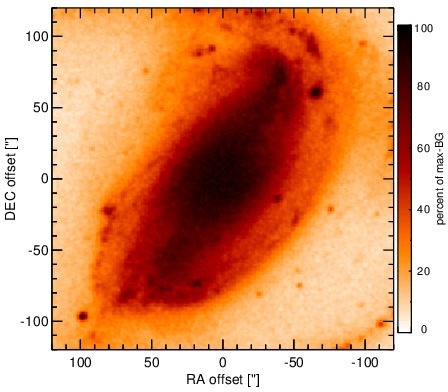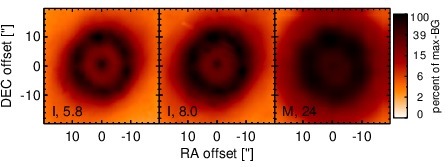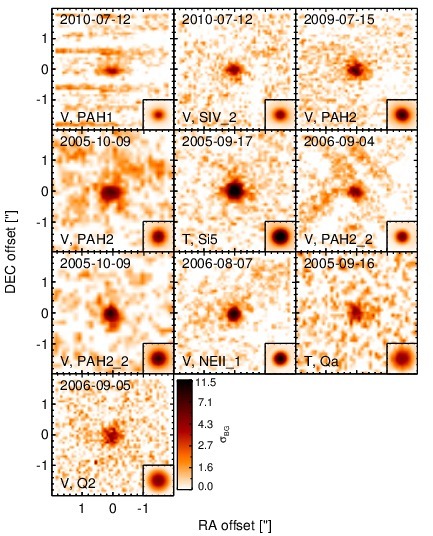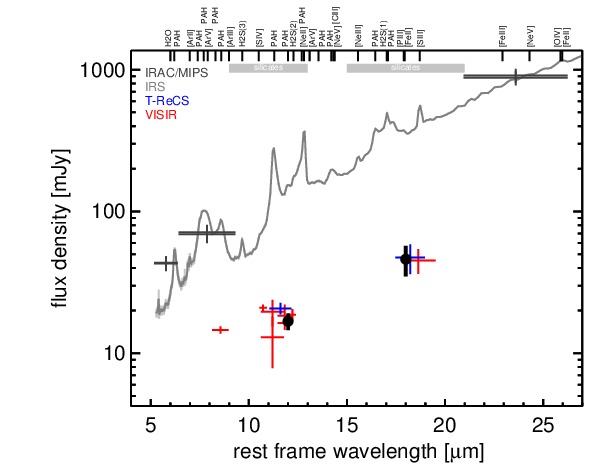Sasmirala Individual Information for NGC 1097
Description
NGC 1097 is a low-inclination grand-design spiral galaxy at a distance of D = 17.0 ± 5.3 Mpc (NED redshift-independent median) with a prominent nuclear starburst ring (diameter~ 18arcsec ~ 1.5 kpc; [hummel_circumnuclear_1987]) and an active nucleus both containing a LINER/Seyfert nucleus with broad double-peaked Balmer lines [storchi-bergmann_double-peaked_1993], and a young massive nuclear star cluster ([storchi-bergmann_evidence_2005]; see [nemmen_radiatively_2006] and [mason_dust_2007] for detailed studies of the AGN). The nucleus is also a flat-spectrum radio source [wolstencroft_vla_1984]. A system of two symmetrical jet-like systems was found around the nucleus (e.g., [lorre_enhancement_1978]). However, these seem to be merger or interaction remnants of stellar origin [carter_jets_1984, wehrle_nature_1997, higdon_minor-merger_2003]. NGC 1097 was first observed at MIR wavelengths by [rieke_10_1978], [telesco_ngc_1981] and [telesco_genesis_1993]. After IRAS, ISO observations [roussel_atlas_2001, ramos_almeida_mid-infrared_2007] and first subarcsecond-resolution N-band imaging with Palomar 5 m/MIRLIN followed [gorjian_10_2004]. The nucleus remained undetected in the latter. In the Spitzer/IRAC and MIPS images, the compact but resolved nucleus and the bright starburst ring are detected. The latter outshines the nucleus with increasing wavelength. Because me measure the nuclear component only, our IRAC 5.8 and 8.0 μm and MIPS 24 μm fluxes are significantly lower than in the literature (e.g., [dale_infrared_2005, gallimore_infrared_2010]). The IRS LR staring-mode spectrum appears completely star-formation dominated with strong PAH features, silicate 10 μm absorption and a red spectral slope in νFν-space (see also [brandl_mid-infrared_2006, mason_dust_2007, smith_mid-infrared_2007, wu_spitzer/irs_2009, bernard-salas_spitzer_2009, tommasin_spitzer-irs_2010, gallimore_infrared_2010]). At subarcsecond-resolution, the nuclear region of NGC 1097 was observed with VISIR in five narrow N-band filters and one Q-band filter in 2005 (unpublished, to our knowledge), 2006 [horst_mid_2008, horst_mid-infrared_2009, reunanen_vlt_2010], 2009 [asmus_mid-infrared_2011] and 2010 (unpublished, to our knowledge). In addition, [mason_dust_2007, mason_nuclear_2012] used T-ReCS to acquire both a Si5 and a Qa filter image in 2005. The compact MIR nucleus and at least part of the starburst ring are detected in all images, albeit partly with very low S/N (e.g., PAH1). The ring is not discussed (but see [mason_dust_2007]). In all images with sufficient S/N (but Qa), the nucleus is marginally resolved (FWHM ~ 0.45arcsec ~ 37 pc). Therefore, we measure only the unresolved nuclear component which provides fluxes lower than total nuclear fluxes in [horst_mid_2008] and [asmus_mid-infrared_2011], but consistent with the PSF fluxes in [reunanen_vlt_2010] and [mason_nuclear_2012]. The subarcsecond fluxes are on average ~ 90% lower than the Spitzer spectrophotometry, which indicates that even the central region inside the starburst ring is totally dominated by diffuse star formation. The nuclear MIR SED indicates that the PAH 11.3 μm feature is also present in the projected central ~ 30 pc. Any AGN contribution in the MIR must thus be very low as already indicated by the absence of [O IV] and [Ne V] emission [bernard-salas_spitzer_2009].
- [asmus_mid-infrared_2011] D. Asmus, P. Gandhi, A. Smette, S. F. Hönig, and W. J. Duschl. Mid-infrared properties of nearby low-luminosity AGN at high angular resolution . A&A , 536 pp. 36, December 2011.
- [bernard-salas_spitzer_2009] J. Bernard-Salas, H. W. W. Spoon, V. Charmandaris, V. Lebouteiller, D. Farrah, D. Devost, B. R. Brandl, Yanling Wu, L. Armus, L. Hao, G. C. Sloan, D. Weedman, and J. R. Houck. A spitzer high-resolution mid-infrared spectral atlas of starburst galaxies . ApJS , 184 pp. 230–247, October 2009.
- [brandl_mid-infrared_2006] B. R. Brandl, J. Bernard-Salas, H. W. W. Spoon, D. Devost, G. C. Sloan, S. Guilles, Y. Wu, J. R. Houck, D. W. Weedman, L. Armus, P. N. Appleton, B. T. Soifer, V. Charmandaris, L. Hao, J. A. Marshall Higdon, and T. L. Herter. The mid-infrared properties of starburst galaxies from spitzer-IRS spectroscopy . ApJ , 653 pp. 1129–1144, December 2006.
- [carter_jets_1984] D. Carter, D. A. Allen, and D. F. Malin. The jets in NGC 1097 . MNRAS , 211 pp. 707–712, December 1984.
- [dale_infrared_2005] D. A. Dale, G. J. Bendo, C. W. Engelbracht, K. D. Gordon, M. W. Regan, L. Armus, J. M. Cannon, D. Calzetti, B. T. Draine, G. Helou, R. D. Joseph, R. C. Kennicutt, A. Li, E. J. Murphy, H. Roussel, F. Walter, H. M. Hanson, D. J. Hollenbach, T. H. Jarrett, L. J. Kewley, C. A. Lamanna, C. Leitherer, M. J. Meyer, G. H. Rieke, M. J. Rieke, K. Sheth, J. D. T. Smith, and M. D. Thornley. Infrared spectral energy distributions of nearby galaxies . ApJ , 633 pp. 857–870, November 2005.
- [gallimore_infrared_2010] J. F. Gallimore, A. Yzaguirre, J. Jakoboski, M. J. Stevenosky, D. J. Axon, S. A. Baum, C. L. Buchanan, M. Elitzur, M. Elvis, C. P. O'Dea, and A. Robinson. Infrared spectral energy distributions of seyfert galaxies: Spitzer space telescope observations of the 12 μm sample of active galaxies . ApJS , 187 pp. 172–211, March 2010.
- [gorjian_10_2004] V. Gorjian, M. W. Werner, T. H. Jarrett, D. M. Cole, and M. E. Ressler. 10 micron imaging of seyfert galaxies from the 12 micron sample . ApJ , 605 pp. 156–167, April 2004.
- [higdon_minor-merger_2003] James L. Higdon and John F. Wallin. A minor-merger interpretation for NGC 1097's ``Jets'' . ApJ , 585 pp. 281–297, March 2003.
- [horst_mid-infrared_2009] H. Horst, W. J. Duschl, P. Gandhi, and A. Smette. Mid-infrared imaging of 25 local AGN with VLT-VISIR . A&A , 495 pp. 137–146, February 2009.
- [horst_mid_2008] H. Horst, P. Gandhi, A. Smette, and W. J. Duschl. The mid IR - hard x-ray correlation in AGN and its implications for dusty torus models . A&A , 479 pp. 389–396, February 2008.
- [hummel_circumnuclear_1987] E. Hummel, J. M. van der Hulst, and W. C. Keel. Circumnuclear star formation in the central region of the barred spiral galaxy NGC 1097 . A&A , 172 pp. 32–42, January 1987.
- [lorre_enhancement_1978] J. J. Lorre. Enhancement of the jets in NGC 1097 . ApJL , 222 pp. L99–L103, June 1978.
- [mason_dust_2007] R. E. Mason, N. A. Levenson, C. Packham, M. Elitzur, J. Radomski, A. O. Petric, and G. S. Wright. Dust and PAH emission in the star-forming active nucleus of NGC 1097 . ApJ , 659 pp. 241–249, April 2007.
- [mason_nuclear_2012] R. E. Mason, E. Lopez-Rodriguez, C. Packham, A. Alonso-Herrero, N. A. Levenson, J. Radomski, C. Ramos Almeida, L. Colina, M. Elitzur, I. Aretxaga, P. F. Roche, and N. Oi. The nuclear infrared emission of low-luminosity active galactic nuclei. AJ , 144 pp. 11, July 2012.
- [nemmen_radiatively_2006] Rodrigo S. Nemmen, Thaisa Storchi-Bergmann, Feng Yuan, Michael Eracleous, Yuichi Terashima, and Andrew S. Wilson. Radiatively inefficient accretion flow in the nucleus of NGC 1097 . ApJ , 643 pp. 652–659, June 2006.
- [ramos_almeida_mid-infrared_2007] C. Ramos Almeida, A. M. Pérez García, J. A. Acosta-Pulido, and J. M. Rodríguez Espinosa. The mid-infrared emission of seyfert galaxies: A new analysis of ISOCAM data . AJ , 134 pp. 2006–2019, November 2007.
- [reunanen_vlt_2010] J. Reunanen, M. A. Prieto, and R. Siebenmorgen. VLT diffraction-limited imaging at 11 and 18μm of the nearest active galactic nuclei . MNRAS , 402 pp. 879–894, February 2010.
- [rieke_10_1978] G. H. Rieke and M. J. Lebofsky. 10 micron observations of bright galaxies . ApJL , 220 pp. L37–L41, March 1978.
- [roussel_atlas_2001] H. Roussel, L. Vigroux, A. Bosma, M. Sauvage, C. Bonoli, P. Gallais, T. Hawarden, J. Lequeux, S. Madden, and P. Mazzei. An atlas of mid-infrared dust emission in spiral galaxies . A&A , 369 pp. 473–509, April 2001.
- [smith_mid-infrared_2007] J. D. T. Smith, B. T. Draine, D. A. Dale, J. Moustakas, R. C. Kennicutt, G. Helou, L. Armus, H. Roussel, K. Sheth, G. J. Bendo, B. A. Buckalew, D. Calzetti, C. W. Engelbracht, K. D. Gordon, D. J. Hollenbach, A. Li, S. Malhotra, E. J. Murphy, and F. Walter. The mid-infrared spectrum of star-forming galaxies: Global properties of polycyclic aromatic hydrocarbon emission . ApJ , 656 pp. 770–791, February 2007.
- [storchi-bergmann_double-peaked_1993] Thaisa Storchi-Bergmann, Jack A. Baldwin, and Andrew S. Wilson. Double-peaked broad line emission from the LINER nucleus of NGC 1097 . ApJL , 410 pp. L11–L14, June 1993.
- [storchi-bergmann_evidence_2005] T. Storchi-Bergmann, R. S. Nemmen, P. F. Spinelli, M. Eracleous, A. S. Wilson, A. V. Filippenko, and M. Livio. Evidence of a starburst within 9 parsecs of the active nucleus of NGC 1097 . ApJ , 624 pp. L13–L16, May 2005.
- [telesco_genesis_1993] C. M. Telesco, L. L. Dressel, and R. D. Wolstencroft. The genesis of starbursts and infrared emission in the centers of galaxies . ApJ , 414 pp. 120–143, September 1993.
- [telesco_ngc_1981] C. M. Telesco and I. Gatley. NGC 1097 - the structure of the central 3 kiloparsecs at 10 microns . ApJL , 247 pp. L11–L15, July 1981.
- [tommasin_spitzer-irs_2010] Silvia Tommasin, Luigi Spinoglio, Matthew A. Malkan, and Giovanni Fazio. Spitzer-IRS high-resolution spectroscopy of the 12 μm seyfert galaxies. II. results for the complete data set . ApJ , 709 pp. 1257–1283, February 2010.
- [wehrle_nature_1997] Ann E. Wehrle, William C. Keel, and Dayton L. Jones. The nature of the optical "Jets" in the spiral galaxy NGC 1097 . AJ , 114 pp. 115, July 1997.
- [wolstencroft_vla_1984] R. D. Wolstencroft, R. B. Tully, and R. A. Perley. VLA observations of the optical jets and nucleus of NGC 1097 . MNRAS , 207 pp. 889–896, April 1984.
- [wu_spitzer/irs_2009] Yanling Wu, Vassilis Charmandaris, Jiasheng Huang, Luigi Spinoglio, and Silvia Tommasin. Spitzer/IRS 5-35 μm low-resolution spectroscopy of the 12 μm seyfert sample . ApJ , 701 pp. 658–676, August 2009.
Images

Optical image (DSS, red filter). Displayed are the central 4 arcmin with North being up and East to the left. The colour scaling is linear with white corresponding to the median background (BG) and black to the 0.01% pixels with the highest intensity.

Spitzer MIR images. Displayed are the inner 40 arcsec with North being up and East to the left. The colour scaling is logarithmic with white corresponding to median BG and black to the 0.1% pixels with the highest intensity. The label in the bottom left states instrument and central wavelength of the filter in micron (I: IRAC, M: MIPS).

Subarcsecond-resolution MIR images sorted by increasing filter central wavelength. Displayed are the inner 4 arcsec with North being up and East to the left. The colour scaling is logarithmic with white corresponding to median BG and black to the 75% of the highest intensity of all images in units of sig_bg. The inset image (where present; either bottom or top right) shows the central arcsecond of the PSF from the calibrator star, scaled to match the science target. The labels in the bottom left state instrument and filter names (C: COMICS, M: Michelle, T: T-ReCS, V: VISIR).
SEDs


MIR SED. The description of the symbols in all the SED plots (where present) is the following: Grey crosses and solid lines mark the Spitzer/IRAC, MIPS and IRS data. The colour coding of the other symbols is as follows: green for COMICS, magenta for Michelle, blue for T-ReCS and red for VISIR data. Darker-coloured solid lines mark spectra of the corresponding instrument. The black filled circles mark the nuclear 12 and 18 micron continuum emission estimate from the data (where present). The ticks on the top axis mark positions of common MIR emission lines, while the light grey horizontal bars mark wavelength ranges affected by the silicate 10 and 18 micron features.